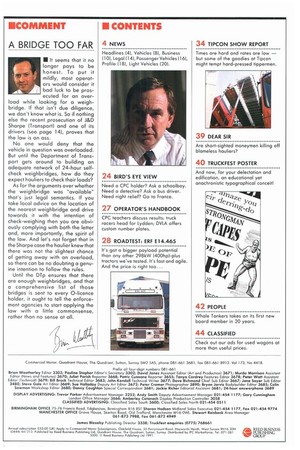A BRIDGE TOO FAR
Page 3

If you've noticed an error in this article please click here to report it so we can fix it.
• It seems that it no longer pays to be honest. To put it mildly, most operators would consider it bad luck to be prosecuted for an overload while looking for a weighbridge. If that isn't due diligence, we don't know what is. So if nothing else the recent prosecution of J&D Sharpe (Transport) and one of its drivers (see page 14), proves that the law is an ass.
No one would deny that the vehicle in question was overloaded. But until the Department of Transport gets around to building an adequate network of 24-hour selfcheck weighbridges, how do they expect hauliers to check their loads?
As for the arguments over whether the weighbridge was "available" that's just legal semantics. If you take local advice on the location of the nearest weighbridge and drive towards it with the intention of check-weighing then you are obviously complying with both the letter and, more importantly, the spirit of the law. And let's not forget that in the Sharpe case the haulier knew that there was not the slightest chance of getting away with an overload, so there can be no doubting a genuine intention to follow the rules.
Until the Dip ensures that there are enough weighbridges, and that a comprehensive list of those bridges is sent to every 0-licence holder, it ought to tell the enforcement agencies to start applying the law with a little commonsense, rather than no sense at all.




















































































